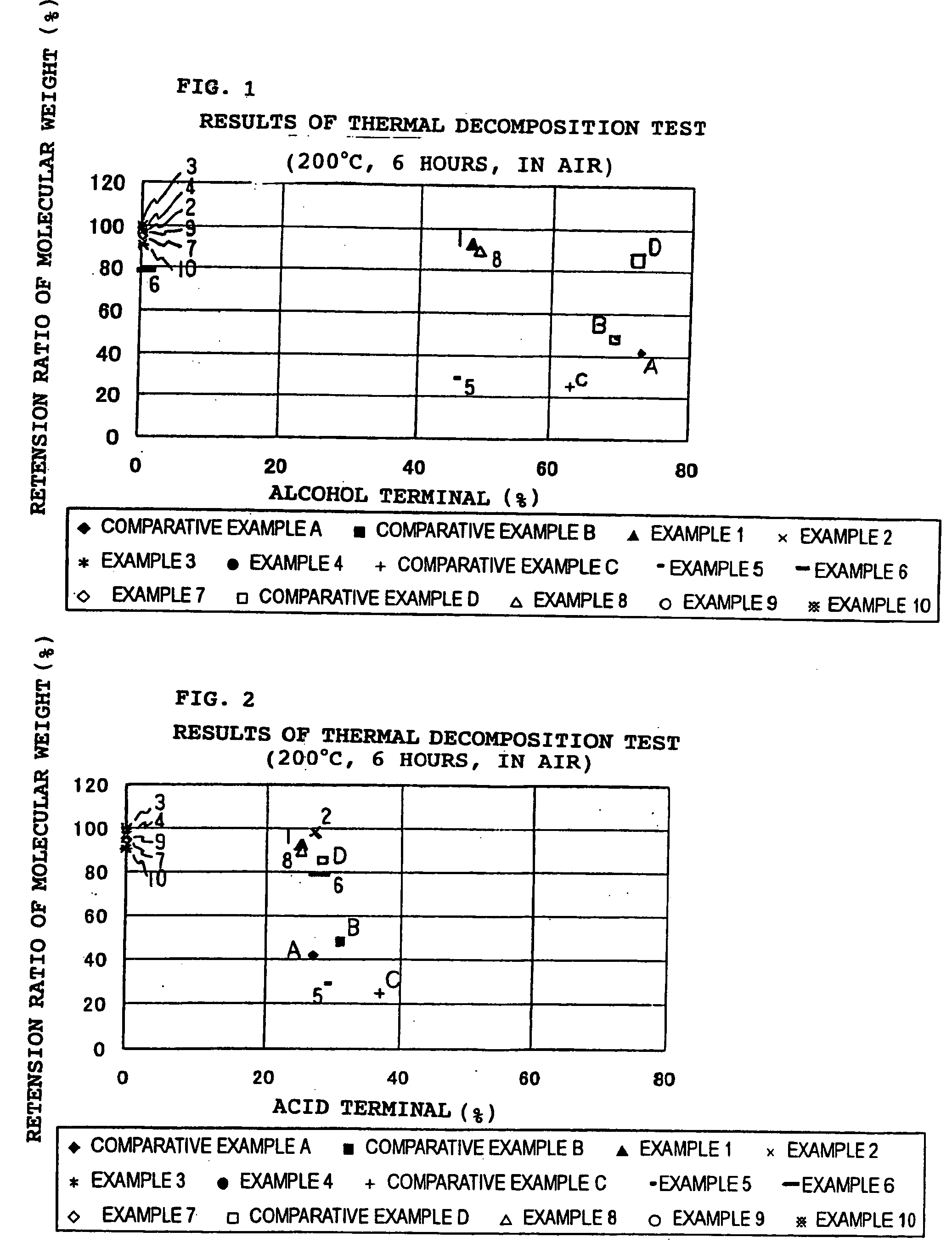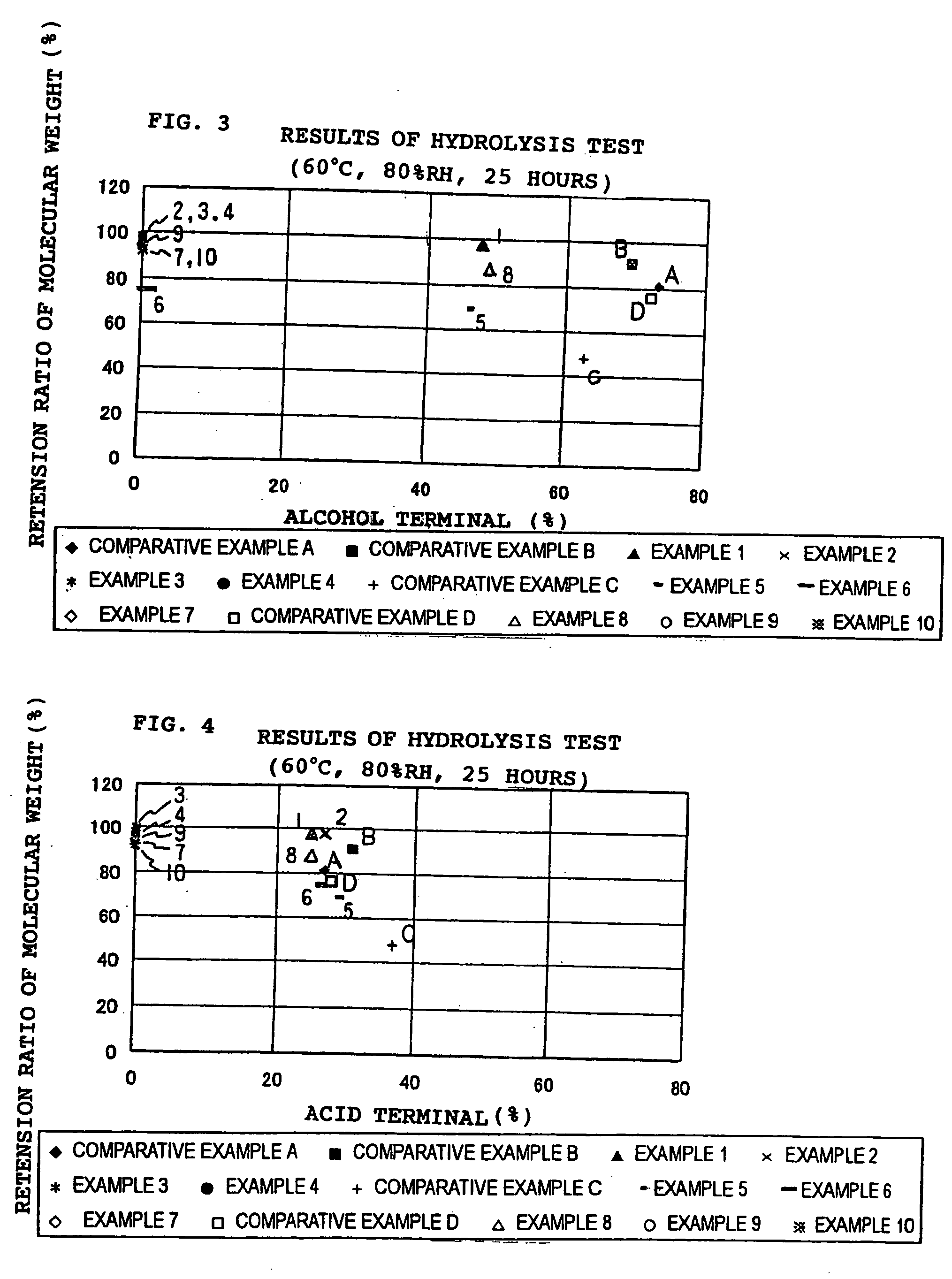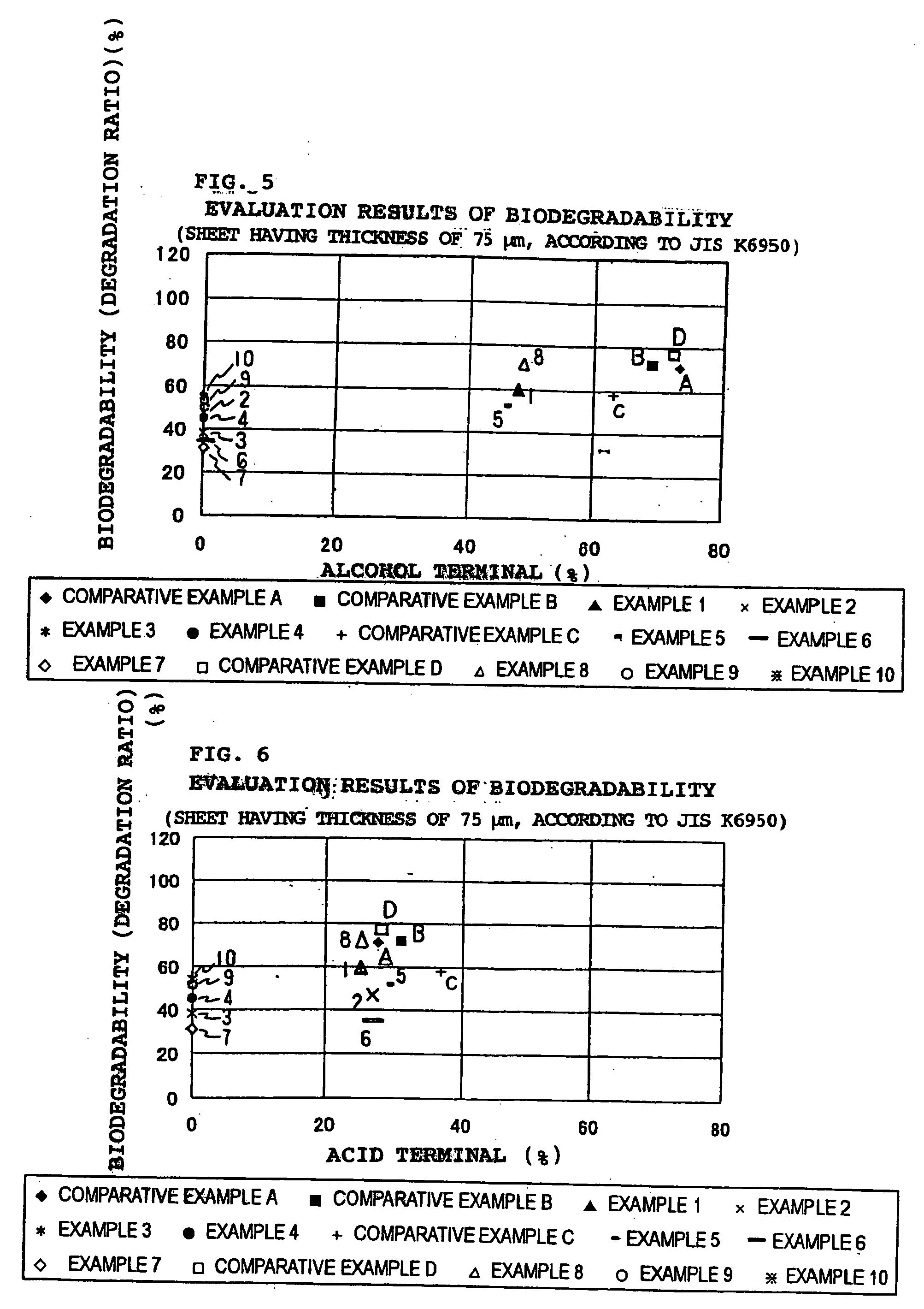In recent years, treatment of waste plastics is becoming a social problem, and recycling of plastics material and biodegradable plastics are paid attention.
In the case of controlling the thermally-decomposing property, hydrolyzability, and biodegradability of the aliphatic polyesters, although there can be obtained a polymer having a desired thermally-decomposing property, hydrolyzability, and biodegradability by copolymerization, there is a problem that the copolymerization also affects to various other physical properties, resulting in that there cannot be obtained a target polymer.
However, it is taught that it is difficult to adjust an elution rate of fertilizing components in all the fertilizing effect-controllable fertilizers.
In the particle-state fertilizers which have been conventionally proposed, the coating layers do not cause degradation or decomposition, and even though those caused the degradation, those remain in soil, resulting in that it is anxious that those produce pollution in the growth of farm products, soil circumstances, and water for irrigation and river around fields.
Particularly, in the conventional particle-state fertilizer coated, it is difficult to control the elution rate of fertilizing components, and there has been a drawback that the fertilizing period is apt to be readily affected by circumstances such as weather and soil.
However, since the polycaprolactone to be employed in the case has a melting point of 60° C., blocking is occasionally caused in transport or storage of products.
However, in the coating material such as the polycaprolactone and polylactic acid, since degradation of the coating materials is too quick, those are not preferred in the case of employing as a gradually-dischargeable fertilizer.
In addition to the above-described problems relating to the coating materials, since the polylactic acid and the aliphatic polyester have a low solubility to solvents, it is difficult to put into practice, resulting in being not sufficiently satisfied.
Accordingly, handling and price of the solvents have been problematic.
In the meantime, it is reported that the above-described polyvinylchloride-based resin which has been preferably employed has a large possibility that it produces harmful substances such as dioxine during burning and dumping, and as a result, a research for substitute resin materials is in progress.
However, if those are thermally melted alone, discoloration and decomposition are simultaneously caused and, further, even though there is applied a so-called block method in which the above-described cellulose derivatives are dissolved, kneaded, compressed, and molded to prepare a sheet, there cannot be obtained a resin having an excellent fluidity in heating and a plasticizing property without the addition of a plasticizer.
However, the cellulose esters containing the plasticizers have a problem that a softening point becomes too low.
However, as a plasticizer which satisfies wide range properties, compatibility, a plasticizing effect, a high transparency, non-volatility, and a non-migrating property, a conventionally known plasticizer having a low molecular weight is known alone, and the plasticizer is apt to readily volatile during molding or after molding.
Accordingly, it has a problem that a working circumstance during molding becomes worse and dimensional stability lowers in a molded article.
Further, the plasticizer migrates toward a pressure sensitive adhesive layer or a printing surface in the marking film, resulting in that an adhesive power lowers in the former and a stain by dust sticking is caused in the latter.
As a result, there is limited the use of a low molecular weight plasticizer for the cellulose derivatives such as the cellulose esters, etc., and it is an existing circumstance that it obstructs an enlargement of uses for a film or a sheet made by the materials, particularly, the use for the marking film, etc.
However, the above-described high molecular weight plasticizer is still insufficient in compatibility with the cellulose ester and, particularly, in the case that it is applied to a cellulose ester having a low substitution degree, it is difficult to prevent that it bleeds out of a molded article, and it volatilizes from a molded article, resulting in that it adversely affects to physical properties such as an outer appearance of a molded article which includes a decrease of transparency by phase separation, and a decrease of a plasticizing effect.
However, the resin which can be readily dyed by a dye has a low softening point and, in the case that a dye-receiving layer is formed in the heat transferable picture image recording sheet using such the resins, the dye-receiving layer and the heat-transfer sheet are adhered to each other by heat of a thermal head during forming a picture image and, when those are stripped from each other, there is caused a problem (a so-called abnormal transfer) that a dye layer in the heat-transfer sheet is entirely transferred onto the picture image recording sheet by fusing each other.
However, a picture image formed blots and storage property is low.
However, in the picture image recording medium, it is difficult to improve a coloring concentration and clearness of a picture image while elevating a strippability from a heat-transfer sheet.
Herein, the plastic film such as the PET occasionally fusedly-adheres to a thermal head by melting in a contact portion to the thermal head because of heat of the thermal head during transferring, resulting in that the recording medium cannot become transferred with a stable speed.
The phenomenon (a sticking phenomenon) not only remarkably lowers a printing quality but also causes a significant noise when the fusedly-adhered film is stripped off from the thermal head, and allows to stop transferring of the recording medium, or occasionally causes a fracture of the substrate.
However, the heat-resistible protecting layer is insufficient for protecting the sticking phenomenon and, in the case that the heat-transferable recording medium is stored in a rolled state, there is caused a so-called blocking phenomenon that the heat-resistible protecting layer adheres to a heat-transferable ink layer.
By occurrence of the blocking phenomenon, the heat-transferable recording medium in a rolled state becomes not occasionally smoothly transferred, components in the ink layer which migrate and adhere to the heat-resistible protecting layer adhere to a heating body in the thermal head and surroundings thereof, resulting in that printing quality is remarkably lowered.
However, since the silicone-graft or block acrylic-based copolymer is poor in a film formability, the back surface layer composed of the copolymer is shaved by the thermal head when continuously printing and, components of the back surface layer adhere to the heating body of the thermal head and circumstances thereof, printing quality lowers as well as in the case of the occurrence of the blocking phenomenon.
For that reason, there is a drawback that the thermal head must be often cleared in order to obtain an excellent printing quality.
However, as well as a method (JP-A-57129789 Official Gazette) in which there is set up a resin layer in which there is added a surface active agent which is solid or semi-solid at ordinary temperatures, there is a drawback that additives such as the silicone oil or the surface active agent migrate toward an ink layer, and there are caused unevenness of transferring and lack of a picture image, resulting in that printing quality is remarkably lowered.
However, there are still remained an inconvenience such as the above-described sticking phenomenon and blocking phenomenon, and an inconvenience such as the unevenness of transferring and a lack of a picture image by migration of the additives toward the ink layer.
As described above, the method for the preparation of the cellulose-modified derivative is complicated in the JP-A-06270561 Official Gazette and, productivity is poor, and the monomers to be employed are expensive.
Accordingly, the methods are not preferred because of a viewpoint of costs.
As described hereinabove, it is an existing circumstance that as the heat-resistible protecting layer for the heat-transferable recording medium, although there have been proposed various materials until now, there is occasionally caused a decline of a printing quality by occurrence of a worse transferring and an abrasion of a thermal head, or occurrence of a fracture, etc. in a substrate and, moreover, a blocking resistance and thermal head stain resistance, etc. are insufficient, and satisfied protecting layers are not found out.
However, since the powdered metals themselves have small electric resistance, although the use amount is small, those are not practical because of a high price.
Further, there is a drawback that since those have large specific gravity, those are separated from resin components and sink in a bottom of a vessel, and those aggregate, and those cause hard-caking during a long term storage, it becomes difficult to disperse again in an original state in spite of agitating, resulting in that there is formed a coating layer containing a small amount of powdered metals, and conductivity becomes worse in a coating layer.
On the other hand, the metal oxides have a drawback that since the metal oxides themselves have a larger electric resistance compared to powdered metals, in the case of intending to obtain a coating layer having equal conductivity to the powdered metals, use amount becomes large, resulting in that there become worse storage stability and physical properties in a coating composition.
Further, it is difficult to obtain a coating layer having an excellent conductivity by a small amount even in the conductive fillers.
Although the conductive carbon is usually mixed and dispersed into a coating using a dispersing machine such as a ball mill or a sand mill, it has a drawback that when the conductive carbon is dispersed until becoming a state of primary particles in the case of dispersing, conductivity of the coating layer becomes poor by formation of a coating layer in which conductive carbon particles do not sufficiently bring into contact each other, and in the case of increasing the mixing amount of the conductive carbon in order to elevate the conductivity, physical properties become poor in the coating layer.
On the other hand, in the case that aggregated particles of the conductive carbon are placed in a large amount without sufficiently dispersing the particles of the conductive carbon, it has a drawback that a storage stability becomes worse in the coating composition, and an outer appearance of the coating layer also becomes poor after finishing.
Also, although the scaly graphite can form a coating layer having an excellent conductivity even in the case of the smaller use amount compared to the conductive carbon, it has a drawback that it is poor in, particularly, an adhering property to a plastic material to be coated and adhesion to an over coating layer.
However, since the acrylic urethane coating is usually a two-liquid type, it must be employed within a fixed time of period, resulting in that it has a problem in coating workability.
Further, in the coating, since a polyisocyanate compound having a relatively low molecular weight is employed as a curing agent, it includes a problem of toxicity and an irritating-property by vapor thereof when coating it at a coating site.
However, the coatings do not attain to properties of the two liquid type acrylic urethane coatings in view of dryability and physical properties which are particularly desired as the ordinary temperature-curable type coatings.
In recent years, treatments of waste plastics are becoming a large social problem, and a biodegradable plastics has been largely paid attention.
), the polyhydroxy butylate, and the polyglycol acid, etc., has a drawback of being hard and brittle because of high crystallinity and rigid molecular structure, and the polyester typified by the polycaprolactone includes a practical problem because of a low melting point.
Therefore, there have been conventionally investigated a method in which a plasticizer is added to a polyester having a high melting point (JP-A-04335060 Official Gazette) and a mere copolymer of a polyester having a high melting point with a polyester having a low melting point (JP-A-07053685 and JP-A-07316271 Official Gazettes), those are not still sufficient from a viewpoint of practical uses.
That is, in the method in which the plasticizer is employed, there become largely problematic a toxicity and low biodegradability of the plasticizer itself, bleed out during molding, and staining of a mold, etc.
In a lactide / E-caprolactone copolymer having a very long chain which is a completely block type as described in the JP-A-07316271 Official Gazette, there is not almost improved a drawback of being hard and brittle, it is exceedingly limited in practical uses.
However, in the case of changing the reaction temperature and catalysts, there are not avoidable fluctuations of preparation conditions and, in the case of consideration of a production change among several grades using an identical production apparatus, it is clear that it becomes a factor of a remarkable decline in productivity.
Accordingly, it is virtually difficult that conventionally known methods are applied to an actual production in an industrial fashion.
 Login to View More
Login to View More 


